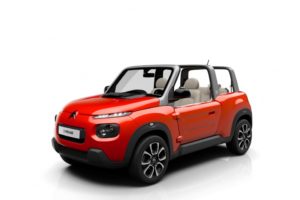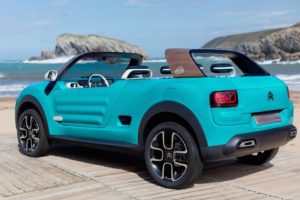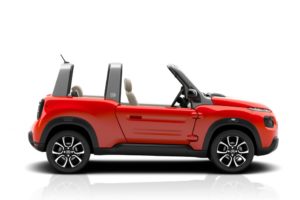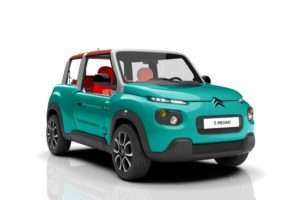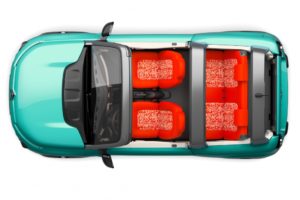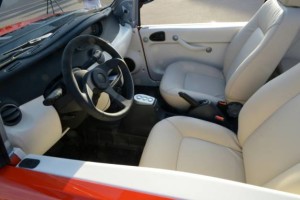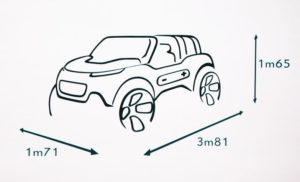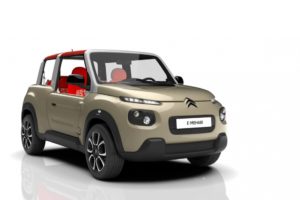In conjunction with the COP21, the 2015 UN Conference on Climate Change, being held in Paris Citroën unveiled the new E-Méhari at a launch event at their design center in Velizy-Villacoublay (near Paris), today. Destined for production in the spring of 2016, it’s timing and limited numbers indicate more of a PR move to show that Citroën is prepared to combat global warming, or at the very least enjoy it while being eco friendly on the way to the beach.
“Incomparable, silent, and stress-free, the E-Méhari stands apart as a free spirit in the automotive market!” reads Citroën’s enthusiastic press release.
The E-Méhari is actually based on two automobiles the PSA Peugeot Citroën Group have already introduced. The exterior design resembles Citroën’s concept Cactus M at shown the 2015 Frankfurt Motor Show. where Citroën did a slick transformation of the C4, morphing its design toward an all-purpose outdoor Méhari-like vehicle, with plastic body panels, ribbed doors and bumpers that have a “second skin” and “Airbumps” similar to the material used in the stock C4 Cactus. The E-Méhari looses the side step indent for rear seat passengers to “hop into” the back and overall the ribbing and the overall style is decidedly more chunky.
The E-Méhari’s platform and drivetrain are from a car Peugeot announced they would be building; – the Bluesummer, an electric small leisure cabriolet designed by Bolloré, a French investment and industrial holding group headquartered in Puteaux, on the western outskirts of Paris. (Bluesummer uses the same electric technology as the successful Bluecar that is used for Autolib, Paris’s auto-share programme.) Peugeot’s Bluesummer will be built at their plant in Rennes, so there is little surprise in Citroën’s announcement that E-Méhari will also be built there.
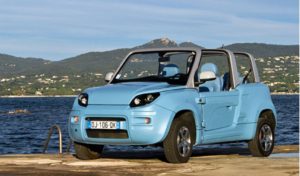 Peugeot Bluesummer
Peugeot Bluesummer  Original Citroën Méhari
Original Citroën Méhari
Ironically the first Méhari was designed outside of Citroën before the company decided to take it into production. It was conceived by French World War II fighter ace Count Roland de la Poype, who headed the French company – SEAP, Société d’Etudes et d’Applications des Plastiques. This company was already a supplier to Citroën, and SEAP developed a working concept based on 2CV mechanicals before presenting it to their client. The E-Méhari represents a Citroën design that conforms to the production constraints imposed by Peugeot working with their supplier Bolloré.
Inspired at least by the original Méhari, the E-Méhari will be powered by a 67-horsepower electric motor being fed by a 30 kW lithium metal polymer battery. Fully charged, the E-Méhari has a top speed of 110kph (68mph) with a range of 200km (124 miles) and can be fully recharged in eight hours on a 16A domestic socket or in 13 hours on a 10A domestic socket.
The E-Méhari “capitalizes on Citroën’s creativity and its capacity to dare,” said Xavier Peugeot, Citroën’s product planning chief at the launch event. “It is not a volume seller but an image accelerator.” He said hotels would be ideal customers to offer guests a “simple and fun” means of transportation while visiting. Fleet and private customers seeking a second a fun, trendy and environmentally friendly car are also among target buyers.
This is not the first time the Méhari has been electrified. During its lifespan from 1968 – 1987, and a production run of 145,000 units, 145,000 copies, the French Army bought 7,064 Méharis and some were modified to have 24 V electric power .
The E-Méhari has a raised chassis to enable it to go off road or onto the beach, along with interior color schemes inspired by water sports and waterproof, plastic-coated interior fabrics. The roof can be folded away and the rear bench seat can be folded to boost cargo space. It will come with a removable soft top (black or orange-red to choose from) and four seat interior washable using a waterjet. Announced exterior colours are; bright blue, orange, yellow or beige.
Exterior dimensions are:
Length: 3.81
Width: 1.87
Height: 1.65
As for price, Citroën would only say that E-Méhari will be “in the middle” of the electric car market.
The E-Méhari will go on sale in France in the spring. At present, 35 employees of the Rennes plant are assigned to manufacture it a rate of 5 cars per day that will increase before the end of the year as it is rolled out across Europe.
Want to get a feel for the market Citroën is targeting? Check out their product launch video here: https://www.youtube.com/watch?v=DMBtJLAu71w


